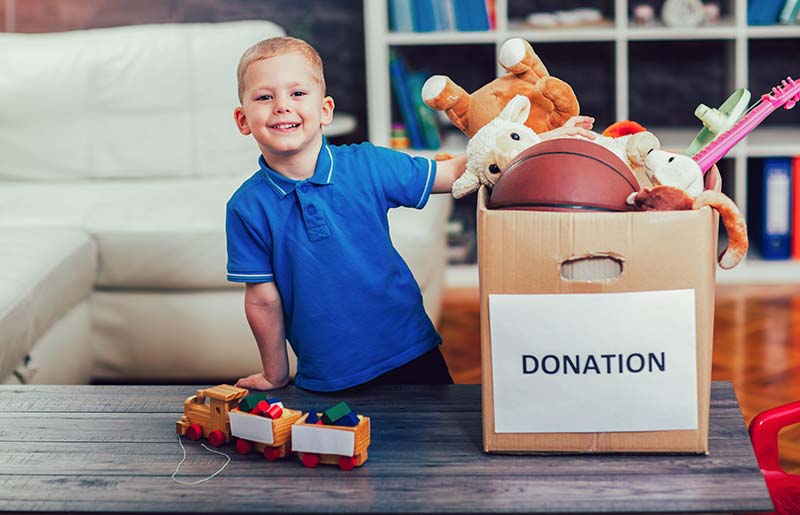
Teach Generosity by Encouraging Giving: The Best Gift of All
A Give-Me Generation
“It feels like our society is too focused on material goods.”
“My children have more things than I ever did growing up, but they don’t seem any happier.”
“How do I help my children to enjoy giving instead of always receiving?”
These comments reflect the concerns of parents at holiday time and throughout the year. They want to raise children who feel good about giving to others, but this generosity of spirit does not always come naturally to children.
It is up to you as a parent to instill kindness and sensitivity toward others and to teach your children skills that reflect generosity.
Creating a Giving Generation
Here are some suggestions to make the concept and the act of giving a part of your regular interactions with your children:
Teach what it means to share
One way you can help your children understand what it means to give is to teach them the importance of sharing. Often, when you think of the word “sharing,” you picture dividing tangible things like splitting a piece of cake with someone or letting friends play with toys.
Even these small examples of sharing can help your children understand, in simple and concrete terms, what it means to be generous.
Model generosity
Think about your attitudes toward charity and what messages you send to your children.
-
Do they reflect the same kindness and sensitivity to others that you would like your children to exhibit?
-
Do your children see you helping neighbors, giving to charity, or donating items to needy people?
Often your children are unaware when you write checks for charity or they do not see you when you run an errand for an infirm neighbor or cook a double batch of dinner for a struggling family. Let them know when you perform acts of kindness.
Talk about your feelings when you give
Tell your children how you feel when you make charitable contributions or buy things for those in need.
-
Do you feel proud, helpful, kind, or generous?
-
Does it make you feel good that you can make a difference in other people’s lives?
Take time at dinner or even while driving in the car to discuss what you do to help others and how it makes you feel.
Do it together
Ask your children to help you when you pack up donations of clothes or household items or when you help a friend. Spend an afternoon at a food bank or at a community clean-up project.
Let them experience first-hand what it feels like to give their time to a cause. Often these activities become the highlight of your family’s time together. Get input from your children and include them in decisions about how your family is going to give to others or be charitable.
Praise the giving impulse
When you see your children being generous, point it out and praise them. Help them put into words the positive feelings they may have as they help others.
If, for example, your son helps his sister find something she lost, tell him that was a kind thing to do and that he can feel proud for taking the time to help her.
Create opportunities
Introduce ideas and opportunities for your children to give time, contribute money, or donate personal items. You might, for example, suggest they visit an elderly neighbor who can’t get out much anymore, choose a charity to support, or give some of their less-used clothes to a community shelter for women and children.
Children usually want to help; they just don’t know how they can make a difference. Talk with them about ways they would want to give back: find activities that are aligned with their interests.
Making Giving Real
Younger children may find the concept of charitable giving a little confusing, especially if the cause does not directly touch their own lives.
Share your stories
Another way of teaching your children to become generous involves your sharing parts of yourself with them. You can tell stories about your life, especially those involving times when you were charitable or participated in fund raising events as a youngster through school, scouts, or places of worship.
If you were ever the recipient of aid, you can talk about what it meant to you to receive a helping hand when you needed it. By sharing your history, you not only serve as a role model, but you also let your children know you more fully as a person.
You will build stronger relationships with them which will allow you to continue to be a strong influence on their behavior and in their lives.
Be generous with your children
You can model generosity by being generous to your children. This can take the form of spending extra time with them, saying kind things to them, doing little extra things for them.
For example, you can make them hot chocolate on a cold winter day or buy them a small toy that they really want but did not expect to receive.
Use gift-giving occasions to teach about giving
Times that traditionally focus on receiving, such as holidays and birthdays, can be great opportunities to encourage your children’s generosity. Help them think about what gifts would suit which people.
Talk about the good feelings that come from choosing a gift that is “right on” for a particular person. Encourage them to participate in some way toward gift-giving, either by contributing money, helping to make a gift, or doing an “act of service” for a family member, such as planting flowers for Grandma on Mother’s Day.
Be patient
Remember that some kids may be reluctant to donate their possessions, time, or money.
Children with certain temperament traits, such as somber moods or a slowness-to-adapt to new ideas, may have a greater difficulty letting go of their old or outgrown possessions.
This is also true of children in certain developmental stages, such as toddlers who develop a sense of their own identity through “owning” things or school-age children who have become collectors and are quite attached to these items.
Children are naturally egocentric and need to be taught to think of others’ needs.
Focus on the good intentions of your children
Look for movement and growth toward greater empathy and “catch them being good” when you see it. Highlight any small act of kindness they demonstrate, even if your son has only selected a single item to give away or has helped for only a short period of time.
Acknowledging even the smallest movement toward generosity will make it more likely that he will become even more generous in the future.
A Parting Thought
The goal is to make the process of giving a natural part of your children’s lives. When being generous feels personal and gratifying for everyone in the household, your children are more likely to grow into kind, charitable, and giving adults.
Patience and modeling on your part will go a long way toward helping your children to develop a spirit of generosity and to discover that giving can be the best gift of all.










